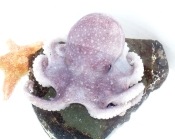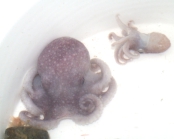
| About | | Search taxa | | Taxon tree | | Search literature | | Checklist | | Stats | | Log in |
WoRMS taxon detailsOctopodidae A. d'Orbigny, 1839
11782 (urn:lsid:marinespecies.org:taxname:11782)
accepted
Family
marine,
Orbigny, A. D. d'. (1836-1842). <i>Mollusques, Echinodermes, Foraminifères et Polypiers recueillis aux Iles Canaries par MM. Webb et Berthelot</i>. In: Barker-Webb, P. & Berthelot, S. (eds) <i>Histoire naturelle des Iles Canaries</i>, volume 2(2): 117 pp., pls 1-7, 7B. pp. 1-24 [Aug. 1839], 25-48 [Sept. 1839], 49-72 [Oct-1839], 73-104 [Jan. 1840], 105-136 [Mar. 1840], 137-143 [Apr. 1840], 145-152 [Aug. 1842]; pl. 1 [Jul. 1836], 2 [Dec. 1836], 3 [May 1842], 4-5 [June 1840], 7 [May 1842], 6, 7B [Aug. 1842]. Paris: Béthune. , available online at https://www.biodiversitylibrary.org/page/41308382
page(s): 13-14 [details]
Description The systematics of the Octopodidae is in a thoroughly unsettled state and the group is very much in need of systematic...
Description The systematics of the Octopodidae is in a thoroughly unsettled state and the group is very much in need of systematic revision. Three subfamilies exist. Octopodinae, Eledoninae, and Bathypolypodinae (see generic list); separated by relatively minor characters, they all are easily recognizable as octopuses. There are 21 currently accepted genera in this large family, however, only Octopus commonly supports major fisheries. [details]
MolluscaBase eds. (2024). MolluscaBase. Octopodidae A. d'Orbigny, 1839. Accessed through: World Register of Marine Species at: https://www.marinespecies.org/aphia.php?p=taxdetails&id=11782 on 2024-12-20
Date action by 2004-12-21 15:54:05Z created db_admin
original description
Orbigny, A. D. d'. (1836-1842). <i>Mollusques, Echinodermes, Foraminifères et Polypiers recueillis aux Iles Canaries par MM. Webb et Berthelot</i>. In: Barker-Webb, P. & Berthelot, S. (eds) <i>Histoire naturelle des Iles Canaries</i>, volume 2(2): 117 pp., pls 1-7, 7B. pp. 1-24 [Aug. 1839], 25-48 [Sept. 1839], 49-72 [Oct-1839], 73-104 [Jan. 1840], 105-136 [Mar. 1840], 137-143 [Apr. 1840], 145-152 [Aug. 1842]; pl. 1 [Jul. 1836], 2 [Dec. 1836], 3 [May 1842], 4-5 [June 1840], 7 [May 1842], 6, 7B [Aug. 1842]. Paris: Béthune. , available online at https://www.biodiversitylibrary.org/page/41308382
page(s): 13-14 [details] basis of record Norman M.D., Finn J.K. & Hochberg F.G. (2014). Family Octopodidae. pp. 36-215, in P. Jereb, C.F.E. Roper, M.D. Norman & J.K. Finn eds. <i>Cephalopods of the world. An annotated and illustrated catalogue of cephalopod species known to date</i>. Volume 3. Octopods and Vampire Squids. <em>FAO Species Catalogue for Fishery Purposes [Rome, FAO].</em> 4(3): 353 pp. 11 pls. [details] status source Strugnell J.M., Norman M.D., Vecchione M., Guzik M. & Allcock A.L. (2014). The ink sac clouds octopod evolutionary history. <em>Hydrobiologia.</em> 725: 215-235., available online at https://doi.org/10.1007/s10750-013-1517-6 [details] status source Taite, M.; Fernández-Álvarez, F.; Braid, H.; Bush, S.; Bolstad, K.; Drewery, J.; Mills, S.; Strugnell, J.; Vecchione, M.; Villanueva, R.; Voight, J.; Allcock, A. (2023). Genome skimming elucidates the evolutionary history of Octopoda. <em>Molecular Phylogenetics and Evolution.</em> 182: 107729., available online at https://doi.org/10.1016/j.ympev.2023.107729 [details] identification resource Lu, C.C. & Chung, W.S. (2017). <em>Guide to the cephalopods of Taiwan</em>. National Museum of Natural Science, Taichung, Taiwan, 560 pp. ISBN 978-986-05-2569-4. page(s): 440 [details]  Present Present  Inaccurate Inaccurate  Introduced: alien Introduced: alien  Containing type locality Containing type locality
Unreviewed
Description The systematics of the Octopodidae is in a thoroughly unsettled state and the group is very much in need of systematic revision. Three subfamilies exist. Octopodinae, Eledoninae, and Bathypolypodinae (see generic list); separated by relatively minor characters, they all are easily recognizable as octopuses. There are 21 currently accepted genera in this large family, however, only Octopus commonly supports major fisheries. [details]
|


